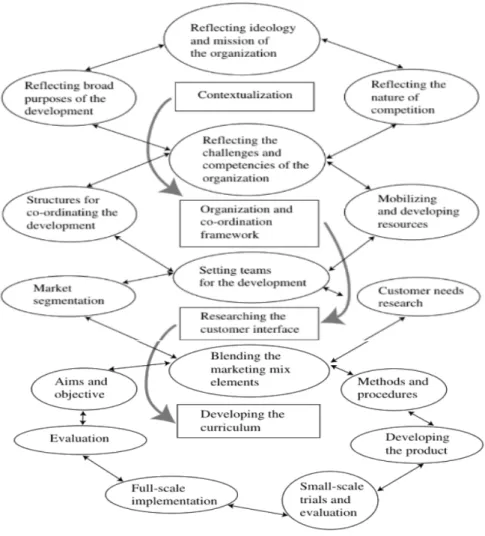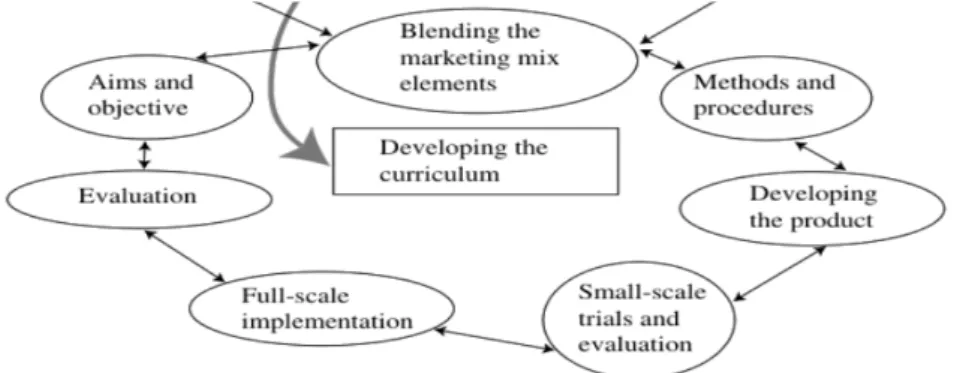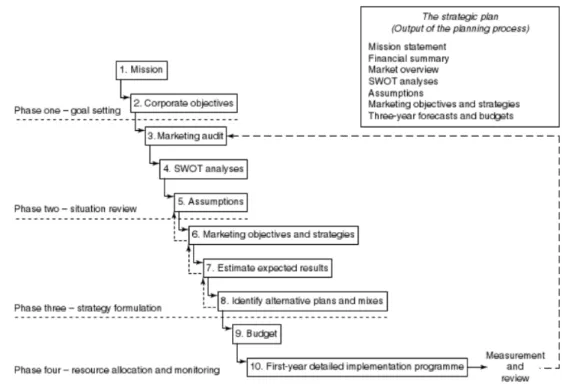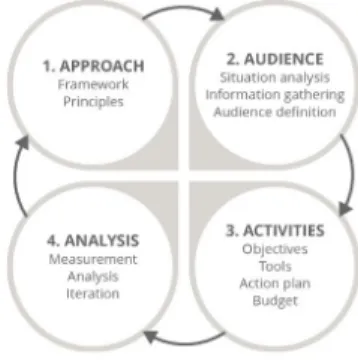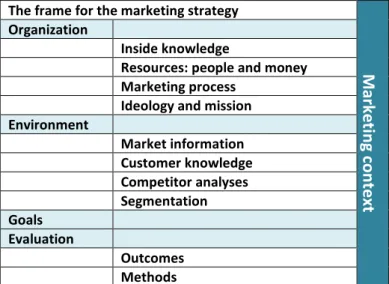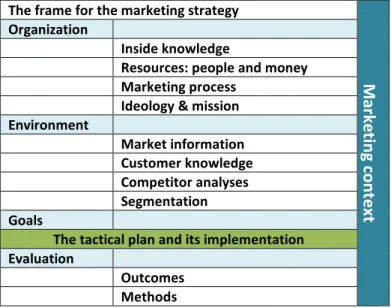The research question of this thesis is: What is the required content for the marketing strategy and how does digitization affect it. The practical side of this thesis focuses on creating a useful marketing strategy framework for the HEI.
What is a marketing strategy?
The first part will focus on the marketing strategy: what it is and what content it should include. As mentioned at the beginning of the chapter, an organization's marketing strategy and business strategy intertwine and complement each other.
The marketing strategy planning process as described by six sources
- Blythe’s five questions
- Fifield’s SCORPIO model
- Gibbs and Maringe’s CORD model
- McDonald’s strategic marketing planning
- Dodson’s four-step process for digital marketing
- The strategy formulation process of Kotler et al
Blythe recommends that if an organization wants their marketing strategy and tactics to be the most profitable, it should be based on the strategic marketing vision of the organization. And what is the quality of the given curriculum from the customer's point of view.
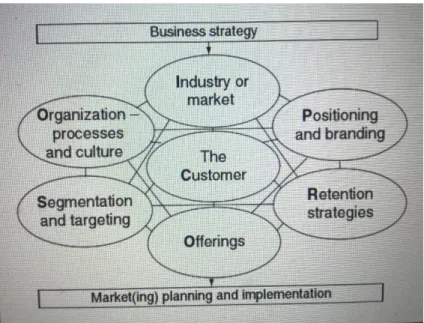
The key components of the marketing strategy frame
Creating a tactical marketing plan that fits with the strategy
The Business Dictionary (n.d.) defines marketing plan as a set of planned marketing activities selected to meet the marketing objectives of a specific target audience within a selected time frame. The plan has its foundation in marketing strategy, and it involves identifying the needs of the specific target group and describing how the company will respond to them with an appropriate level of return. In the plan there must also be an analysis of the opportunities and trends in the markets and a detailed action program, budget, sales forecast and accounting are all necessary.
They look at the marketing planning process from the service business side and suggest that the planning process is a seven-step process; if followed, should lead to approval of the plan by. Alignment of goals; agreeing on goals for growth that are consistent with the organization's strategy and goals. Implementation; implementing the plan carefully, but still being open to modifying the plan if changes or new opportunities arise during implementation.
When implementing new marketing opportunities, there is always the need to integrate technologies, adapt strategies and fit new tasks into the marketing team's schedule. According to previous knowledge, the tactical marketing plans should be added to the marketing strategy process after goal setting, but before evaluation.
How digitalization affects marketing and marketing strategy
The importance of digitization has also been compared to the industrial revolution, as it will greatly affect the whole of society (Kiiski & Kataja 2016, p. 9). This more holistic view, where digital marketing is not only seen as a set of marketing tactics, is also supported by Kannan and Hongshuang (2017, p. 22), who say that the meaning of digital marketing has changed over the years from digital channels. used in marketing for the overall process of using digital technologies in marketing. Looking at these broader views, digital marketing should mean much more than using digital marketing tactics or isolated digital processes.
According to Parviainen, Kääriäinen, Tihinen and Teppola (2017, p. 66), the impact and goals of digitization can be broadly divided into three categories: internal efficiency, external opportunities and disruptive change. In previous Adobe studies, there were even indications that implementing new digital marketing tactics—such as The same study shows that companies that put effort into comprehensive and continuous improvements to their digital marketing program, or digital maturity, saw better ROI from their tactics compared to companies that made more isolated changes to separate tactics.
The same kind of results can also be seen in the Boston Consulting Group's (BCG) analysis of their digital marketing survey, where they report that companies more advanced on the digital marketing maturity path than others experienced 30% cost savings and a 20% increase in revenue. (Field, Patel & Leon 2018). Based on these findings, it can be argued that achieving better business will be possible when the entire marketing strategy is influenced by digitization, not just the tactical planning or individual parts of the strategy.

Starting to create a marketing strategy with digital understanding
- Revealing the existing stage of the organization
- Evaluating the existing stage of digital marketing maturity
- Exploring the external environment for marketing
- Setting goals for marketing
- Evaluation
- Digitalization in HAMK’s marketing
Tikkanen (2005, pp. 176–177) sees that marketing strategy objectives must be either quantitative or qualitative and formed directly from the organization's business strategy and business objectives. The picture of the current situation is based on information collected from the management of HAMK, SCD and on meetings with people who plan marketing tactics of various HAMK services and carry out marketing themselves. Stakeholder marketing is in the hands of SCDs, deans and managers (Lassila-Mersalo, Linko & Kosunen 2018).
When talking about the service categories of HEI marketing, applicants are the largest service group and are directed most of the marketing resources. Currently, there is high diversity in how marketing is planned and executed at the different levels of the organization. The level of all marketing varies greatly due to the difference in the marketing competence of the people responsible.
The first step of development was to look at the existing level of marketing. It was clear that despite successful marketing and advertising for various customer segments of HAMK, there was no strategic planning for the marketing of the entire organization at the same time.

The marketing strategy frame tailored for the needs of HAMK
Still, more mature digital marketing methods, such as long-term planning for digitization, goal setting and fully digital processes, and a skills renewal plan, have not been added to HAMK's marketing processes (HAMK marketing board 2018). In order to achieve the desired result, to create a detailed framework for the marketing strategy of HAMK, which will support their upcoming creation of a marketing strategy and ensure digital development in it, the work should start by adding more information to the basic framework (as we learned in section 2.3 , page 18 ). When adding two levels – the third and fourth levels – the levels should drill down into the information and guide the process to the desired level of detail needed.
HAMK's marketing; it is also intended to help with the process and guide thinking towards digitization. The brand and values have been chosen to specify the ideology and mission element as these two definitions are used in HAMK's strategic communication and HAMK's business strategy. HAMK has a tradition of monitoring and measuring current market conditions and industry trends, so the topics fit well with HAMK's environmental analyses.
Communication channels have not been mentioned by the authors, but the topic is included here because it is one of the elements of customer journey mapping that some HAMK marketers use in their analyzes (HAMK marketing board 2018). Dodson (2016) also mentions segment-based marketing content, which fits well with HAMK's marketing principles, because HAMK emphasizes content marketing when it is reasonable to think about segment-based marketing content.

Testing the first version of the frame
The second test version of the frame
When commenter 2 mentions that there should be more information on how to set functional KPIs and calculate the appropriate ROI, it is good to note that the framework presented here is only a basis for strategic marketing planning of an organization, not an actual plan or guidance how to make it happen. This leads to an obvious need to deepen knowledge on how to take the steps mentioned in the framework and share good practices with all employees involved in marketing. Comment 3 also points in the same direction: people who are not marketing experts could check the necessary fields from the framework.
Although the comments collected are not representative of all those involved in HAMK marketing, these comments together give positive indications of the need for a written HAMK marketing strategy framework. The comments collected were neutral or positive in tone, and commenters saw relevance between the framework and the marketing of HAMK. This level of feedback is enough to convince us to continue to push forward the work on the marketing strategy framework.
When the feedback and willingness of HAMK management is combined, it seems clear that the framework for marketing strategy should be published for marketers and managers and put into operation as a tool for marketing planning at HAMK.
The results of the project and continuation
When the new strategy for HAMK is announced, SCD should be ready to start creating a HAMK marketing strategy together with senior management and HAMK's marketing board. The marketing strategy must continue HAMK's new strategy and open it up for the marketing perspective. Once the HAMK level of the marketing strategy has been defined, all major service categories should focus on HAMK level information and detail it to fit each service category.
In order to ensure the quality of planning at every level of marketing strategy, the SCD must define the information required for the planning process in executing the marketing strategy at the HAMK level. They must also provide necessary instruction and guidance for managers and marketers working with every level of HAMK's marketing strategy. There should also be training opportunities for people who need more knowledge about marketing to work within HAMK's criteria if the need arises.
In general, adopting the marketing strategy framework for the upcoming creation of HAMK's marketing strategy should provide the necessary tools for their work. If the frame is to become part of HAMK's marketing process, it must be improved every step of the way as the understanding of strategic marketing planning grows in the organization.
Key findings
The knowledge in it was deepened into four layers, chosen on the basis of their relevance to the organization. Relevance was considered by the nature of the organisation's higher education institution, its desire to increase digitization, and their marketing process and expectations. Because the organization has a three-tier structure in their marketing, information about the active layers in each category has been added to the frame.
As a conclusion regarding the practical development work, the marketing strategy framework created for HAMK seems to fulfill the ambition of the task. It is based on the theory of marketing strategy, supplemented with the information that fits the nature and will of the organization, and the result is tested, so we know that the shape of the framework fits the organization.
Future development
The author’s comments
